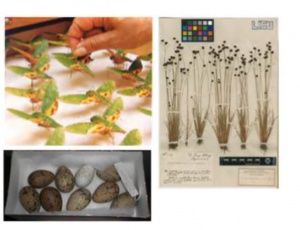Objectives
Natural history museums are privileged spaces for seminal research on different subjects of biological sciences such as biodiversity, evolution, ecology, biogeography and taxonomy. This crucial role is due to the fact that they represent biological diversity repositories becoming huge libraries of information on Earth living organisms. The long-term sampling through various decades renders tonatural history collections an historic perspective that allows reconstructing a “memory”, sometimes secular, of natural patterns and processes. This aspect gains particular relevance nowadays because of the increasing rate of species extinctions and biodiversity decrease.
This course aims:
- To evidence the importance of natural history collections for the study of biodiversity.
- To show new tools and approaches to extract and disseminate biodiversity data from natural history collections
- To increase awarene of young researchers for the scientific and culture value of Natural History Museums.
This course has a recognition of 6 ECTs for FCUL PhD students enrolling in it as part of their first doctoral year. For FCUL PhD students only requiring 5 ECTs in their specific PhD programmes, the last 6 hours of the course are not mandatory and the certificate will be on 'Topics in Natural History Collections and Biodiversity’.
Minimal formation of students: bachelor degree in Biology or related areas
Directed to: PhD or MSc students in Biology, Evolution, Ecology or related areas, and postdocs and other professionals working in related topics.
General Plan
A. Introduction. What are scientific collections? Why do we keep scientific collections? What to keep in the biological collections? (2h)
B. NHC in Biodiversity Assessment Studies. The role of natural history collections in biodiversity research.The role of natural history collections to determine areas of conservation importance and
estimate species richness and diversity, in documenting species declines, in Environmental Impact Assessment (EIA) studies, in Legal Medicine, and in monitoring air quality. (3h)
C. New Natural History Collections: Tissue and DNA Collection as biological repositories and its role in the preservation of biological resources. Classification of Tissue and DNA Collections (aims, target species and types of biological material). Conservation of DNA and of biological tissues. Collection management. Ethical issues. Sound Archive. Challenges to the traditional definition of specimen. Technological aspects. Collection of natural sounds: acquisition, databases, storing, access, Intellectual Property Rights (IPR), data quality. Seed banks and the Conservation of Biodiversity. Definition, historical context and their contribution to the conservation of biodiversity. Long-term seed conservation: basic principles. Seed collecting and curation procedures. Management of seed bank collections. Seed longevity under storage conditions. (5h)
D. NHC and the Study of Biodiversity in Portugal. The beginnings of the natural history collections in Portugal. The first institutional scientific collections of the XVIII century. Brief overview of current natural history collections, herbaria and Botanical Gardens in Portugal. (2h30)
E. NHC Management. What does management mean? Management in practice: the pathway from nature to museum reserves. Types of collections and of collecting. Storage and conservation conditions. Loans and loan conditions. Scientific curation (Identifying specimens, literature, incorporating new research). (3h)
F. New Technological Tools to the Study of NHC. Genetic history and Museomics. Defining Museomics. Increasing importance of NHC in genetic studies. The curator's job and the new techniques. Sources of DNA in NHC specimens. Working with DNA from NHC specimens - difficulties, precautions and new possibilities. Stable isotopes in ecology: the role of natural history collections.What are, how to measure and how to express stable isotopes? Sampling animal tissues for stable isotope analysis. Using stable isotopes to determine trophic relationships in animal populations. Stable isotopes as tracers to infer geographical origins and movements of migratory animal populations. The value of NHC in isotopic studies. 3D Imaging. 3D Imaging principles. Equipment and techniques. Use of imaging to study biological specimens and 3D visualization. 3D anatomical databases. (4h)
G. Biodiversity informatics and Museum-based informatics. Digital capture of natural history collection data. Major initiatives, applications and impact. Global Biodiversity Information Facility (GBIF). (3h)
H. NHC and the environmental education. Collections of NH museums as tools to promote environmental education and facilitate attitudes and behaviours pro environment. The projects Natural Europe, Inquiry and Key to Nature. (1h30)
I. Visits MUHNAC’s natural history collections. (6h)
J. Theme presentation and discussion. 6 h
Funding
Students fees
Partners
n.a.
Fee
Free for 1st year PhD students in the Doctoral program in Biology (FCUL), Biodiversity, Genetics and Evolution (BIODIV UL; UP) and Biology and Ecology of Global Changes (BEAG UL, UA) when the course counts credits for their formation, in which case the delivery of a final report done after the course is mandatory; 25 € for PhD students from institutions of the PEERS network (cE3c, CFE); 125 € for FCUL Master students and unemployed; 180 € for BTI, BI and other PhD students; 250 € for Professional and postdocs.
When the maximum number of students is reached 8 vacancies will be available for non-paying 1st year PhD students mentioned above, being, by order of preference: 1) cE3c students; 2) BIODIV students (not from cE3c); 3) FCUL students (not from cE3c); 4) BEAG students (not from FCUL).
To apply send an e-mail to Maria Judite Alves at the following email address: mjalves@fc.ul.pt
with a cv, motivation letter and the following information:
Full Name:
E-mail:
Phone:
Professional activity: Professional/Postdoc, BTI, BI (or other non-post-doc research grant), PhD student (with/ without scholarship), Lic. (Bachelor)/Master student
Academic formation:
PhD student of the 1st year of Doctoral programme BIODIV (FCUL/FCUP), Biologia (FCUL) or BEAG (FCUL or UA)?:
If yes to the above question, PhD student doing the Course to count credits for 1st year?:
PhD student of cE3c or CEF (Centro de Ecologia Funcional):?
If PhD student from another programme/centre, which:
mjalves@fc.ul.pt

